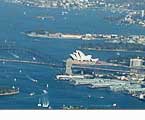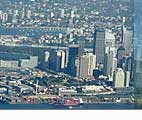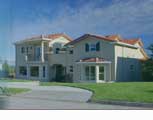



| |
 |
 |
High home prices sustainable: RBACHRIS ZAPPONESydney Morning Herald, November 25, 2009 Australians can cope with high home prices, even as first home buyers struggle to enter the market, according to the Reserve Bank. RBA deputy governor Ric Battellino said that Australian households appeared to have the capacity "to sustain a relatively high ratio of housing prices to income" but older, more financially secure households had seen the biggest benefit of home price rises so far. The wealth accumulated by older Australians through superannuation funds and nearly 20 years without a recession had encouraged more borrowing for upgrades and improvements later in life, Mr Battellino said, creating a "significant factor" in the housing market over the past 10-15 years. By comparison, under 35 first-home buyers had experienced "a noticeable decline in home ownership over the past 10–15 years," he said. "It may be that this is being driven by demographic factors – such as the fact that young people are staying in education longer and delaying the formation of new households – but it may also be financially driven," he said. Real expenditure on new homes was now 60 per cent higher than it was around 15 years ago, he said. Mr Battellino predicted that Australia's trade with the growing Asian economy would help keep Australia's economy on sound footing in years to come. With strong population growth helping to keep unemployment low, household income should rise, which would underpin demand for housing. However, as the economy grows, driven in part by resources exports, the industry will compete with the construction industry for workers. First home buyers The rising cost of a deposit on a first home had become a barrier for entry into the housing market for younger buyers, he said. "On plausible assumptions, the deposit needed by first-home owners may now be around one and a quarter years' income, almost twice what it was 15 years ago." The proportion of people who owned their homes outright has fallen from 42 per cent in 1994-95 to 33 per cent in 2007-08, the Australian Bureau of Statistics said this month, while the amount owing on homes had doubled to $150,000 and the median home value had doubled to about $400,000. Mr Battellino said government grants for first home buyers - such as the First Home Owners Buyers Grant enacted in October 2008 and scaled back in September of this year - principally helped only the first entrants into the market. "Various governments have sought to provide concessions to first-home owners through grants or tax relief," he said. "However, while these measures assist the first wave of buyers who are able to take advantage of them, the benefits diminish over time to the extent that these concessions become capitalised into higher house prices." Renovations and replacements "Almost half of all dwelling investment has been accounted for by alterations and additions in recent years," Mr Battellino said. Also, more new houses being built were replacements for existing houses that had been demolished. The Housing Industry Association is tipping a 56,000 home shortage in 2009, which will remain at least until 2012. Industry analysts blame the chronic shortage of available homes in part for the high cost of Australian housing relative to similar economies elsewhere. Median home prices in capital cities have increased almost continually since at least since 1986, jumping 28.1 per cent from 2003-04 to the June quarter 2009 alone, data from Australian Bureau of Statistics shows. Household debt as a share of disposable income also rose from about 50 per cent in 1993 to about 150 per cent in 2008, according to separate numbers from the RBA. In today's speech, Mr Battellino said the RBA estimated that from 2001 to 2006, about 15 per cent of new houses built had replaced houses that had been demolished. The figure was under 10 per cent 10–15 years earlier. A "significant proportion" of investment appeared to have gone into holiday homes or second homes, the statement said. "Census data show that the number of dwellings built has exceeded the increase in the number of households by a large margin." The ratio of the number of dwellings to the number of households has been rising over time with 8 per cent more dwellings in Australia than households in 2006. "Presumably, most of this surplus reflects holiday houses and second houses," Mr Battellino said. 'Reasonably relaxed' In the speech, "the RBA seemed reasonably relaxed on the issue of housing stress-debt suggesting that international comparisons are difficult to make and that households appear to have 'the capacity to sustain' relatively high house prices," said RBC Capital Markets economist Su-Lin Ong. "This partly reflects the RBA's view - highlighted in some of its other research - that those with the highest debt levels are generally best able to manage it, the impact of accumulated compulsory superannuation savings, and some factors specific to Australia which encourage the faster paydown of debt." University of Melbourne finance professor Les Coleman said rising house prices was asset inflation by a different name. "The RBA talks up a storm about controlling inflation for good and proper reasons… it’s no different with assets." "If you have rampant inflation it induces people to make poor financial decisions." |